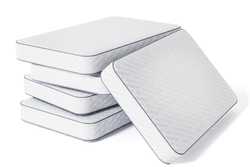How to Wash a Comforter: A Step by Step Guide

Our evaluations and opinions are not influenced by our advertising relationships, but we may earn a commission from our partners’ links. This content is created by TIME Stamped, under TIME’s direction and produced in accordance with TIME’s editorial guidelines and overseen by TIME’s editorial staff. Learn more about it.
Just like your pillows and sheets, even the best comforters become soiled over time by your natural skin oils, sweat, and the occasional stain—even with a duvet cover. Unfortunately, the largest piece of laundry you own isn’t the easiest to clean.
Washing a comforter the wrong way can ruin the cozy materials inside, promote harmful mold growth, or break your washing machine if you end up overloading it. The good news is that while it may be a bit of a chore, properly washing a comforter is relatively easy to do if you know the best techniques, and it’s well worth the trouble to ensure that you’ll have a fresh comforter to sleep under during that next icy night. Here’s what you need to know to perfectly clean your favorite comforter inside and out, while keeping it in top condition for years to come.
While you should immediately spot-clean your comforter when spills and accidents happen to prevent long-lasting stains, you shouldn’t have to wash it too often, especially if you use a removable duvet cover. A duvet cover should be washed two to four times a year, and plan on running it through the washing machine before you store one away for the season.
Since many comforters are shielded by a duvet cover as a set of sheets securely covers the mattress underneath, the comforter itself needs to be cleaned only once or twice a year.
Comforters without a duvet cover should be washed much more often because they come into direct contact with your skin. Households who share beds with pets and anyone suffering from common allergies, such as dust or dander may need to wash their comforter even more frequently.
Step 1: Select a gentle wash cycle and a cool or warm temperature setting.
Step 2: Add a mild, scent-free, and additive-free detergent to your washing machine. Note that using fabric softener is likely to damage the feathers inside a down comforter. As a safe alternative, add a half-cup of distilled white vinegar to help rinse away remaining detergent from your comforter.
Step 3: Distribute the comforter evenly balanced inside the washing machine to allow water and detergent to efficiently flow around the comforter.
Step 4: It can be difficult to tell if a comforter has been rinsed properly, so consider adding a second rinse cycle to flush away as much detergent residue as possible. You may need to remove and reinsert the comforter for its second rinse to ensure that the water is able to rinse formerly folded sections and clumped-up pockets of comforter filling.
Remember to always check your comforter’s tag before running it through the dryer, as some materials must be air dried.
Step 1: Do your best to spread the comforter out evenly inside of the dryer. This helps the dryer to evenly dry the comforter as it tumbles.
Step 2: Adjust the settings to low or no heat, and begin the drying cycle.
Step 3: Remove the comforter every 25 minutes and manually fluff it to prevent clumping.
Step 4: Repeat until the comforter is dry. Please note that a moist comforter is especially attractive for mold and mildew, so ensure it’s completely dry before storing or putting it out on your bed.
Ask yourself if you really want to wash a comforter with your own hands—because a soggy comforter is heavy and it may take a few days to dry completely. If handwashing is your best option, this is the most effective method.
Step 1: Fill a bathtub halfway with water, add a cup of detergent, and stir the solution with your hands. The water temperature should be comfortable to the touch, since you will immerse your hands and arms in it to wash the comforter.
Step 2: Submerge the comforter and lightly stir the water around the tub.
Step 3: Let it soak for 10 to 15 minutes, and then drain the bathtub.
Step 4: Thoroughly rinse the comforter with warm water to wash away all traces of detergent.
Step 5: Gently press down on the comforter to draw out leftover water. While this may be a time-consuming step, being too rough with the comforter in an attempt to quickly squeeze out lingering moisture may damage its insides.
Step 6: Set the comforter out to dry in a well-ventilated area. Pointing a circulating fan at the drying rack will significantly reduce drying time.
![[object Object] [object Object]](https://images.bloomingdalesassets.com/is/image/BLM/products/1/optimized/11530601_fpx.tif)
Definitely! Between lingering chemicals used in the manufacturing process and the likelihood that irritating particles have made contact with your new comforter as it was packaged and shipped out, you’ll want to give it a thorough cleaning before you put it on your bed. This is an especially important rule for people with sensitive skin, as sleeping under new and unwashed comforters and bed sheets may cause itchiness and skin inflammation.
Unless your comforter’s cover features a dry-clean only note on its label, it’s generally better to wash your comforter yourself. Not only will you save money by doing it yourself, if you have a washing machine large enough to comfortably fit the comforter, it’s far more convenient.
While it's convenient to wash all of your laundry at home, if you don’t have a washing machine with a capacity of at least 5.0 cubic feet to give your comforter the space it needs to be cleaned, a laundromat with a commercial washing machine is your best bet.
If your home washing machine is too small to clean a comforter, water and detergent won’t have room to wash over and completely clean the comforter—and you run the risk of overloading the appliance. Avoid a “washed,” yet still dirty comforter and the expensive costs of repairing or replacing your washing machine by opting for a trip to the laundromat instead.
That depends: Refer to the instructions noted on your comforter’s tag before you dry your comforter. If your comforter is dryer-friendly, expect the process to take 40 to 50 minutes and note you may need a large-capacity dryer of at least 7.0 cubic feet to dry your comforter effectively.
Also, while a few tennis balls or wool balls may work wonders for fluffing your normal laundry, a large comforter will need at least an additional five to ten, as well as a large-capacity dryer for this technique. If your dryer is too small, consider air-drying your comforter on a drying rack in a well circulated area as an alternative.

The information presented here is created by TIME Stamped and overseen by TIME editorial staff. To learn more, see our About Us page.



